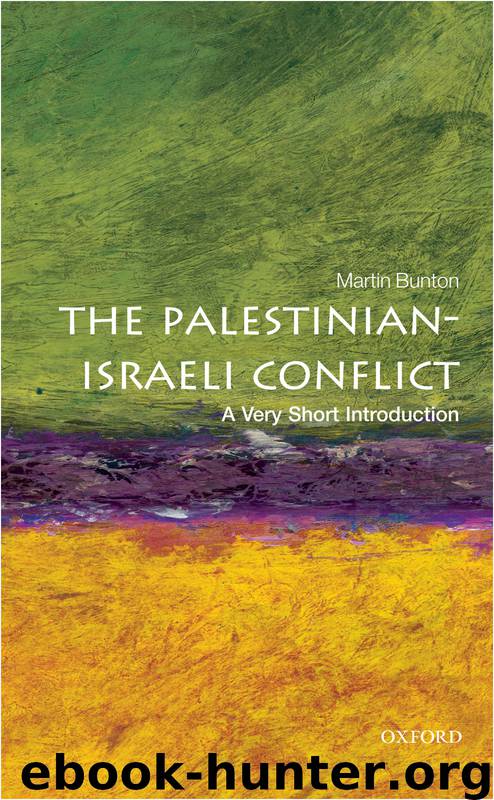The Palestinian–Israeli Conflict: A Very Short Introduction by Martin Bunton

Author:Martin Bunton
Language: eng
Format: epub
Publisher: Oxford University Press
Published: 2013-07-07T16:00:00+00:00
Atzmaut: Israeli independence
On 14 May 1948, David Ben Gurion declared Israel’s independence as a ‘Jewish state established by and for the Jewish people’. With both the Soviet Union and the United States quickly recognizing Israel, the new state nonetheless had to fight hard for its survival against the Arab forces which immediately attacked it. Born in a hostile regional situation, the Israeli state confronted daunting challenges, especially with regard to demography and security.
When the regional war came to an end in mid 1949, the state of Israel had a population of 800,000, of whom 160,000 (or about 20 per cent) were Palestinian Arabs who remained in, or close to, their homes. Although they were given Israeli citizenship, they were also regarded as a fifth column and placed under military government that dated back to Britain’s harsh mandatory emergency regulations. Even after the military administration came to an end in 1966, certain exclusionary practices towards the Arab population continued, prominent among them budgetary inequality and the discrimination involved in being prohibited from buying or leasing land.
By the terms of the 1950 Law of Return, Israeli citizenship was guaranteed to Jews from around the world. By 1951, the population of Israel had almost doubled, to over 1.3 million. Approximately half of these new immigrants were European (Ashkenazi) Jews, and the other half Mizrahi (also known as Sephardic, or Oriental, Jews) arrived from Arab countries. The reasons behind the exodus of Jews from the Arab world were varied—some were attracted by Zionist ideals or encouraged by Israel to emigrate; others (particularly in Iraq) fled anti-Semitism and systematic persecution—but the result was the same: ancient Jewish communities in cities such as Baghdad all but disappeared. Although attempts have been made to link, as part of an overall ‘population exchange’, the property claims of the Mizrahi immigrants to those of the Palestinian refugees, some observers have questioned the fairness of politicizing the issue in this way. While Palestinian claims for compensation are against Israel, Jewish claims are not against Palestinians, but rather against other Arab countries, which were either not involved in the war for Palestine (Morocco, Tunisia, and Libya, for example) or were caught up in their own complex process of decolonization (for example, Algeria).
The challenge of absorbing the surge of immigrants into the new state of Israel was twofold: on the one hand, the government needed to find them housing and jobs; on the other, it sought to imbue a common sense of citizenship. Certainly, Israel’s remarkable economic growth during the first decade or so smoothed the task of settling the new immigrants. The government was able to pursue highly ambitious and interventionist spending programmes thanks to the massive amount of money transferred to it in the form of donations from world Jewry, reparations for the Holocaust from the West German government, and some defence aid from countries such as France and the United States. The government’s control over the urban and agricultural property that had belonged to Palestinian Arab refugees also helped a great deal, as new Jewish immigrants, for example, moved into abandoned Arab homes.
Download
This site does not store any files on its server. We only index and link to content provided by other sites. Please contact the content providers to delete copyright contents if any and email us, we'll remove relevant links or contents immediately.
| Arms Control | Diplomacy |
| Security | Trades & Tariffs |
| Treaties | African |
| Asian | Australian & Oceanian |
| Canadian | Caribbean & Latin American |
| European | Middle Eastern |
| Russian & Former Soviet Union |
The Secret History by Donna Tartt(18943)
The Social Justice Warrior Handbook by Lisa De Pasquale(12165)
Thirteen Reasons Why by Jay Asher(8841)
This Is How You Lose Her by Junot Diaz(6831)
Weapons of Math Destruction by Cathy O'Neil(6214)
Zero to One by Peter Thiel(5730)
Beartown by Fredrik Backman(5673)
The Myth of the Strong Leader by Archie Brown(5456)
The Fire Next Time by James Baldwin(5380)
How Democracies Die by Steven Levitsky & Daniel Ziblatt(5170)
Promise Me, Dad by Joe Biden(5112)
Stone's Rules by Roger Stone(5051)
A Higher Loyalty: Truth, Lies, and Leadership by James Comey(4905)
100 Deadly Skills by Clint Emerson(4878)
Rise and Kill First by Ronen Bergman(4739)
Secrecy World by Jake Bernstein(4698)
The David Icke Guide to the Global Conspiracy (and how to end it) by David Icke(4655)
The Farm by Tom Rob Smith(4465)
The Doomsday Machine by Daniel Ellsberg(4449)
